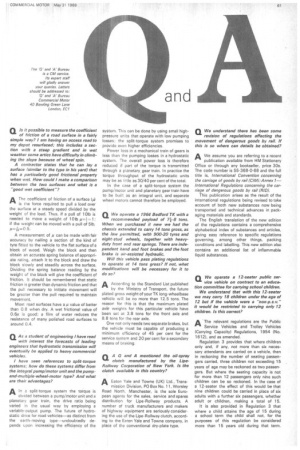Q Is it possible to measure the coefficient
Page 63

If you've noticed an error in this article please click here to report it so we can fix it.
of friction of a road surface in a fairly simple way? I am having an access road to my depot resurfaced; this includes a section with a steep gradient and in wet weather some artics have difficulty in climbing the slope because of wheel spin.
A contractor states that he can lay a surface (similar to the type in his yard) that has a particularly good frictional property when wet. How could I make a comparison between the two surfaces and what is a "good wet coefficient"?
A The coefficient of friction of a surface (y)
is the force required to pull a load over the surface at a steady speed divided by the weight of the load. Thus, if a pull of 10Ib is needed to move a weight of 10Ib p-=1 =1: if the weight can be moved with a pull of 51b, A measurement of y can be made with fair accuracy by nailing a section of the kind of tyre fitted to the vehicle to the flat surface of a block of wood. Weigh the block and then obtain an accurate spring balance of appropriate rating, attach it to the block and draw the block slowly and steadily across the surface. Dividing the spring balance reading by the weight of the block will give the coefficient of friction. It should be remembered that static friction is greater than dynamic friction and that the pull necessary to initiate movement will be greater than the pull required to maintain movement.
Most road surfaces have a /..t value of better than 0.8 when dry. A wet frictional value of 0.6,u is good; a film of water reduces the resistance of many polished road surfaces to around 0.4.








































































































